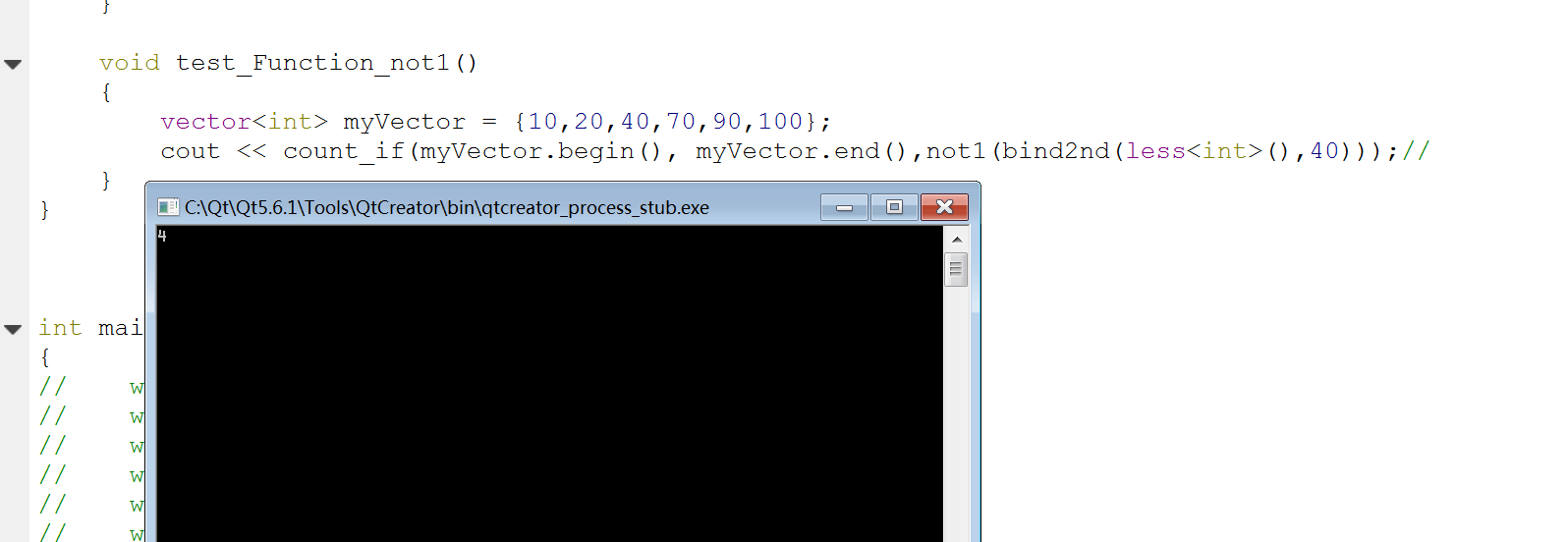技术在于交流、沟通,本文为博主原创文章转载请注明出处并保持作品的完整性
概要:
1.仿函数
2.bind2nd()
3.not1()
4.bind()
仿函数的实现:声明一个类,重载它的operator call ("()"操作符)
template<typename T> class lineFeed { public: void operator()(const T &x) { cout<<x<<endl; } };
仿函数只为算法服务,但是像上面这种声明方式,虽然在有些时候可以使用,但是却不能融入STL,因为有可能在"仿函数适配器"上出现编译错误,下面我们来看看STL中的仿函数.
仿函数的使用可以看一下我的上一节博客,虽然都没有继承自 binary_function<T,T,bool>,unary_function<T,bool>...
STL中的仿函数大致可以分为三个类
1.算数类
template<typename _Tp>
struct plus : public binary_function<_Tp, _Tp, _Tp>
{
_Tp
operator()(const _Tp& __x, const _Tp& __y) const
{ return __x + __y; }
};
template<typename _Tp>
struct minus : public binary_function<_Tp, _Tp, _Tp>
{
_Tp
operator()(const _Tp& __x, const _Tp& __y) const
{ return __x - __y; }
};
...
2.逻辑运算类
template<typename _Tp>
struct logical_and : public binary_function<_Tp, _Tp, bool>
{
bool
operator()(const _Tp& __x, const _Tp& __y) const
{ return __x && __y; }
};
template<typename _Tp>
struct logical_or : public binary_function<_Tp, _Tp, bool>
{
bool
operator()(const _Tp& __x, const _Tp& __y) const
{ return __x || __y; }
};
template<typename _Tp>
struct logical_not : public unary_function<_Tp, bool>
{
bool
operator()(const _Tp& __x) const
{ return !__x; }
};
...
3.相对关系类
template<typename _Tp>
struct equal_to : public binary_function<_Tp, _Tp, bool>
{
bool
operator()(const _Tp& __x, const _Tp& __y) const
{ return __x == __y; }
};
template<typename _Tp>
struct not_equal_to : public binary_function<_Tp, _Tp, bool>
{
bool
operator()(const _Tp& __x, const _Tp& __y) const
{ return __x != __y; }
};
...
我们会看到所有的STL仿函数都需要继承binary_function<T, T, bool>(两个参数)或者unary_function<T, bool>(一个参数),只有继承自这两种父类,你声明的仿函数才可以融入STL
上面提及到仿函数适配器, 如果不继承上面这两种类, 在执行到某个阶段会报错.
下面是binary_function<>与unary_function<>的源码
binary_function<T, T, bool>,发现binary_function<>
template<typename _Arg1, typename _Arg2, typename _Result>
struct binary_function
{
/// @c first_argument_type is the type of the first argument
typedef _Arg1 first_argument_type;
/// @c second_argument_type is the type of the second argument
typedef _Arg2 second_argument_type;
/// @c result_type is the return type
typedef _Result result_type;
};
unary_function<T, bool>
template<typename _Arg, typename _Result>
struct unary_function
{
/// @c argument_type is the type of the argument
typedef _Arg argument_type;
/// @c result_type is the return type
typedef _Result result_type;
};
那么为什么没有继承自这两个类,会报错呢?我们看上面的源码,他们的内部都有typedef,这几个typedef是为了提取算法传进变量,以供仿函数适配器使用,如果你没有继承这两种类,那么在算法调用仿函数时,仿函数适配器提取不出这几个变量,那么就会报错.
写仿函数,一定要继承上面这两个类.
仿函数适配器
下面介绍几个仿函数用的适配器函数
1.bind2nd().它的作用是绑定仿函数的第二参数
它本身就是一个仿函数的适配器,它的作用是为我简化binder2nd(),因为binder2nd()的参数类型比较复杂,我们在调用的时候回很不方便.
先看一个测试函数
namespace wzj007 { void test_Function() { vector<int> myVector = {10,20,40,70,90,100}; cout << count_if(myVector.begin(), myVector.end(),bind2nd(less<int>(),40));//返回vector中value小于40的个数 } }

现在解释一下bind2nd()函数的作用: 它将40 这个变量绑定在less()函数的第二参数上,less函数返回第一参数是否小于第二参数,那么绑定后的less()函数就应该返回 传入的参数是否小于40
小于40的value有10,20.那么输出的结果应该是2.那么具体是怎么绑定上的呢
我们先看一下less()的源码
template <class T> struct less { bool operator() (const T& x, const T& y) const {return x<y;} typedef T first_argument_type; typedef T second_argument_type; typedef bool result_type; };
他也是一个仿函数,但是却发现它没有继承自binary_function<T, T, bool>,因为他自己声明了那三种typedef,他需要两个两个参数,x和y,返回 x是否小于y.
那么 bind2nd(less<int>(),40) 他的含义就应该是 比较传进参数x,是否小于40(y);
下面我们来看一下是怎么绑定上的
这是bind2nd()的源代码
template<typename _Operation, typename _Tp> inline binder2nd<_Operation> bind2nd(const _Operation& __fn, const _Tp& __x) { typedef typename _Operation::second_argument_type _Arg2_type;//这有一个typedef 它提取出operation的第二参数,同时可以检测第二参数类型 return binder2nd<_Operation>(__fn, _Arg2_type(__x)); }
这个binder2nd()的源码,binder2nd()是一个仿函数,他的作用是绑定仿函数的的第二参数
template<typename _Operation>
class binder2nd
: public unary_function<typename _Operation::first_argument_type,
typename _Operation::result_type>
{
protected:
_Operation op;//取出传进的仿函数
typename _Operation::second_argument_type value;//取出第二参数,同时可检测第二参数类型
public:
binder2nd(const _Operation& __x,
const typename _Operation::second_argument_type& __y)
: op(__x), value(__y) { }//构造函数(在bind2nd()函数中调用),初始化自身成员变量 op,value
typename _Operation::result_type
operator()(const typename _Operation::first_argument_type& __x) const
{ return op(__x, value); }//重载operator() 在函数count_if()中被调用
// _GLIBCXX_RESOLVE_LIB_DEFECTS
// 109. Missing binders for non-const sequence elements
typename _Operation::result_type
operator()(typename _Operation::first_argument_type& __x) const
{ return op(__x, value); }//非const
} _GLIBCXX_DEPRECATED;
这是count_if()的源码
template <class Inputerator, class Outputerator, class Predicate> typename iterator_traits<Inputerator>::difference_type; count_if(Inputerator first, Inputerator last, Predicate pred) { typename iterator_traits<Inputerator>::difference_type; for( ; first != last; ++first) if(pred(*first)) //这个地方会调用函数pred(*first), 重上面我们可以看到 pred绑定的函数是binder2nd()中的 operator()函数,那么此时的pred就应该是less函数 ++n; return n; }
现在band1st()的含义我们应该可以猜到了吧.
not1()将函数的返回值取否
他也是一种仿函数适配器,简化我们调用unary_negate()
void test_Function_bind2nd() { vector<int> myVector = {10,20,40,70,90,100}; cout << count_if(myVector.begin(), myVector.end(),not1(bind2nd(less<int>(),40)));// }

调用not1()之前返回的是小于40的value有几个,那么取否后就应该是不小于40的value有几个: 4个(40,70,90,100)
看一下是怎么关联上的
not1()源码
template<typename _Predicate> inline unary_negate<_Predicate> not1(const _Predicate& __pred) { return unary_negate<_Predicate>(__pred); }//调用unary_negate()的构造函数
unary_negate()源码
template<typename _Predicate>
class unary_negate
: public unary_function<typename _Predicate::argument_type, bool>
{
protected:
_Predicate _M_pred;
public:
explicit
unary_negate(const _Predicate& __x) : _M_pred(__x) { }//not1()调用构造函数初始化成员变量
bool
operator()(const typename _Predicate::argument_type& __x) const
{ return !_M_pred(__x); }//取反 count_if()调用其operator()
};
bind() C++11的绑定函数

这些函数是C++11的一些变更函数,原来的函数仍然可以使用,从上面可以看出 bind2nd改名为bind();
那么bind()具体怎么使用呢
这份代码是我在http://www.cplusplus.com上拷下来的
namespace wzj008 { // a function: (also works with function object: std::divides<double> my_divide;) double my_divide (double x, double y) {return x/y;} struct MyPair { double a,b; double multiply() {return a*b;} }; void test_Function_bind() { using namespace std::placeholders; // 使用placehloders _1(第一参数占位符), _2(第二参数占位符) ,_3(第三参数占位符)... // binding functions: auto fn_five = std::bind (my_divide,10,2); // returns 10/2 将10 绑定在my_divide()函数的第一参数上, 2绑定在my_divide()函数的第二参数上 10/2 = 5 std::cout << fn_five() << '\n'; // 5 auto fn_half = std::bind (my_divide,_1,2); // returns x/2 使用占位符_1 即将my_divide()函数的第一参数绑定为传入参数, 2绑定为my_divide()函数的第二参数 std::cout << fn_half(10) << '\n'; // 5 10/2 = 5 auto fn_invert = std::bind (my_divide,_2,_1); // returns y/x 使用占位符_2 即_2为函数my_divide()的第二参数, _1为my_divide()的第一参数 std::cout << fn_invert(10,2) << '\n'; // 0.2 10(_2)为第二参数 2(_1)第一参数 2/10 = 0.2 auto fn_rounding = std::bind<int> (my_divide,_1,_2); // returns int(x/y) 将fn_rounding()绑定为my_divide()函数 std::cout << fn_rounding(10,3) << '\n'; // 3 MyPair ten_two {10,2}; //绑定成员变量 // binding members: auto bound_member_fn = std::bind (&MyPair::multiply,_1); // returns x.multiply() std::cout << bound_member_fn(ten_two) << '\n'; // 20 将传进参数ten_two{10,2} 的10和2 分别赋给 a和b(a = 10, b = 2) 10 * 2 = 20 auto bound_member_data = std::bind (&MyPair::a,ten_two); // returns ten_two.a 给a赋值 a = 10; std::cout << bound_member_data() << '\n'; // 10 } }
参考侯捷<<STL源码剖析>>






















 333
333











 被折叠的 条评论
为什么被折叠?
被折叠的 条评论
为什么被折叠?








